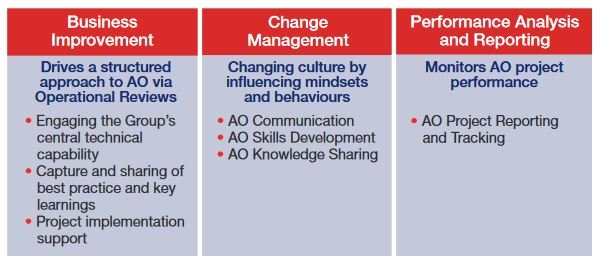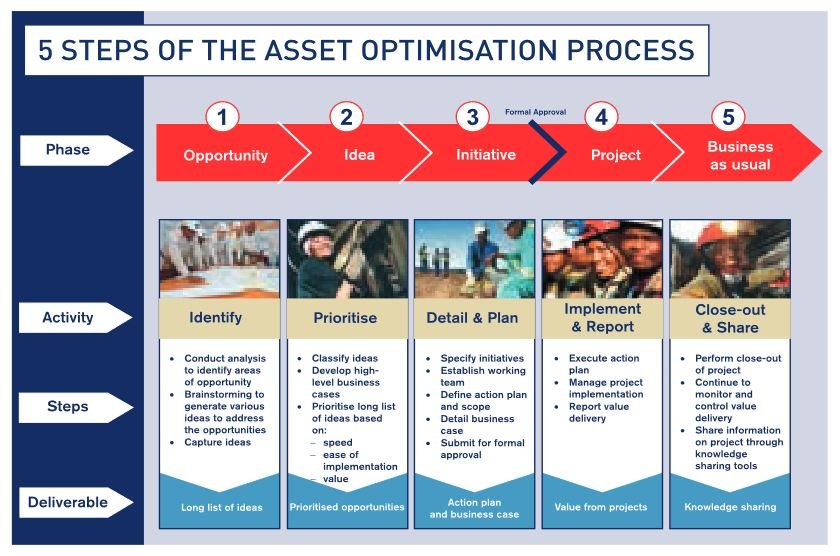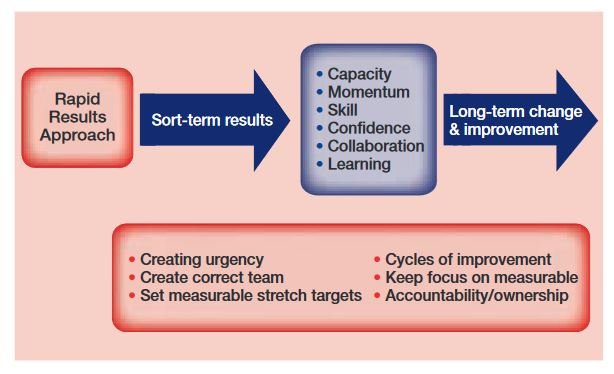
Anglo American is one of the world’s largest mining companies. The company operates in Africa, Europe, South and North America, Australia and Asia. It owns a portfolio of mining
businesses and natural resources. These include diamonds and platinum group metals. Other activities include the mining and extraction of copper, iron ore and coal. The company employs
over 100,000 employees. In 2010 its operating profit was almost $10 billion.
Today, Anglo American is a more focused and performance orientated international mining company. It has a clear strategy in place to drive forward its ambition of being the investment partner and employer of choice in the mining industry. Part of this strategy is its Asset Optimisation (AO) programme.
The AO programme was designed around a holistic approach to both the health (skills development, mindsets and behaviours) and performance (cost and productivity improvements) of Anglo American’s operations. The AO programme has continued to deliver benefits by unlocking additional value across the Group. It creates a business culture whereby employees are encouraged to work together and come forward with initiatives to improve the business.
A key feature of development within the AO program was its design, piloting and introduction into Anglo American’s day-to-day business. This was supported by a formalised internal process called Operation Reviews (OR). The OR process, delivered entirely with internal resources, combines the strength of Anglo American’s central technical capacity with the operational expertise from across the Group to create a team focussed on delivering value from operational improvement. Teams are made up in such a manner that the company is able to leverage its global best practice across the Group’s complete mining value chain.
This case study shows how Anglo American ensures it operates in the most efficient way possible. Since 2008 Anglo American has, through the implementation of its AO programme, been able to deliver on its stated target of saving $1 billion from core operations by 2011.
Reviewing operations
A company should continually review its processes to ensure they are as efficient as they can be. Every aspect of what a business does needs to be subject to a review process. An effective review process can secure business improvement. Making improvements then helps the business to maximise its efficiency, competitiveness and profitability.
To achieve improvements Anglo American employees continually question and challenge existing ways of doing things to identify more efficient methods. This involves improving procedures and processes. Procedures are a series of actions or operations that need to be performed in set ways. A process is an act of implementing these procedures. Once improvement opportunities have been identified, such as a more efficient method of extracting a raw material, they are shared across the Group.
Operation Reviews (ORs) are identified by Anglo American as an important process to improve performance. The ORs apply a structured evaluation process in three functional areas:
- Operational improvement (revenue enhancement and cost reduction)
- Technical assessment (technical risk and adherence to technical standards)
- Safety and sustainable development assessment (S&SD risks and value opportunities).
The OR process assists managers at particular sites as well as business unit managers. It provides a framework against which identified value opportunities can be realised while putting in place value enabling processes to identify further possibilities for business improvement.
Operations consist of all of the activities that the company carries out associated with its business. Operations range from the process of mining the raw materials to dealing with customers and building relationships in the communities in which it operates. Operational Reviews take place at selected Anglo American sites. Any improvements that are identified will be shared across the whole of the organisation.

The illustration shows Anglo American’s eight step operation review process. Kick-off is the start of the process at a particular site, such as one of Anglo American’s coal mines. This is followed by the diagnosis stage where problems and areas for improvement are identified.

The team is then able to identify the scope of the process change to be implemented (e.g. how to cut coal more quickly and efficiently). The team then works together on site for a week to detail the business case for making real improvements in working practice. Creating the business case will include deciding what resources will be needed to secure the improvement (e.g. employing new cutting technologies). Once this has been agreed the project is approved and implemented. The improvement opportunity is then shared across the organisation to become best practice.
Asset management and optimisation
Like any other company Anglo American manages a value chain. The value chain is the chain of activities involved in making a product more desirable to the end user. For Anglo American this involves extracting natural resources which may be thousands of metres underground. Minerals and metals then need to be transported and treated before they can be made into finished products. Anglo American seeks to add value in every process that it is responsible for in the chain. Adding value often involves reducing waste, cutting costs, saving time and improving efficiencies.
Anglo American’s approach to adding value is referred to as Asset Optimisation (AO). AO is a programme of activities designed to ensure that operational performance is maximised relative to cost. This is achieved by owning the most attractive assets i.e. the natural resources, capital, technical know-how and workforce skills that give the biggest returns. Optimisation is the process of achieving the best possible performance across the organisation. This is achieved by using the learning from Operational Reviews (ORs) across the organisation. Combining the expertise of the central technical team with local teams provides ideas for new ways of working that can be applied across Anglo American.
Asset Optimisation concentrates on three components:

Business improvement will only be sustained if it is backed up by change management. People’s attitudes and ways of working need to positively support change. This is referred to as an ‘improvement culture’. The culture of an organisation is the typical way of working and thinking. A ‘yes we can’ approach to working is required where employees are willing to suggest better ways of working and commit themselves to these new methods. The third
fundamental aspect of making a business improvement culture ‘stick’ is to have certain controls in place. In the case of AO this is achieved through an auditable reporting system that aims to track project delivery and financial impact.
Asset Optimisation, therefore, helps Anglo American to:

- unlock the value of its resources, equipment and people
- establish an improvement culture within the organisation
- create improvements across the value chain from resources right up to the customer.
The important thing to understand about AO is that it is not just a one-off programme. It is continuous and ongoing. The AO programme therefore links closely to the Japanese concept of Kaizen. Kaizen is also known as continuous improvement. It involves all workers within an organisation making ongoing improvements to quality in their work. For it to get results, the culture of continuous improvement must filter through the entire organisation. Workers are empowered to make decisions affecting quality. This leads to lower wastage levels and reduced costs.
Anglo American’s people need to understand what AO means. This is achieved through communication, learning and development opportunities.
- AO communication involves providing messages across the whole of the organisation. These messages show what is involved in AO and outline the success stories achieved through ORs. Company magazines, posters and newsflashes are used to drive awareness and understanding to all workers.
- AO Academy Training involves providing training opportunities for employees to learn about all aspects of AO and ORs. Participants are able to share experiences of introducing improvements. The academy fosters the skills and culture needed to deliver AO results for the business.
The Asset Optimisation process
Anglo American’s optimisation process sets out a clear view of how operational improvement can be planned for. There are five phases, starting with identifying an opportunity and finishing with putting an improvement into practice.
An example of this process was the recent development of methane flaring at the New Denmark coal mine in South Africa. The colliery drills boreholes from the surface to drain the build-up of methane (a harmful greenhouse gas) in the mine.

Opportunity stage – In 2010 the ventilation and occupational health manager at the mine, motivated by a genuine concern for the environment, started to investigate ways to reduce the mine’s carbon footprint. He found that methane flaring is regarded to be a clean development approach. Here was an opportunity to reduce the mine’s environmental impact. The problem was that the boreholes were situated at remote farms and different boreholes needed to be used on a regular basis.

Idea stage – A number of options were investigated but research indicated that a mobile flare design would solve the problem. A Swiss company was commissioned to design a suitable device. Methane flaring involves burning the released methane gas. The by-products of flaring have a much lower greenhouse effect than the methane.
Initiative stage – A detailed plan was then put together with technical experts from Anglo American.
The project stage – The plan was approved and nine million Rand was allocated to the project in 2010.
Business as usual – The volume of methane flared each day is registered at the central control room. The project has been registered with a United Nations approved verification agency. The project flares four tonnes of methane per day. This earns precious recognition and a financial reward, in the form of carbon trading, to the company for its efforts in greenhouse gas management.
The project is estimated to provide a return of 4 million Rand a year for the first ten years of operation. The project is ongoing and the methods are being shared across Anglo American.
Benefits of Asset Optimisation
In 2009, the target of achieving annual benefits of $1 billion was set for AO. In the first year $1.6 billion of benefits were achieved. In 2010, over $2.1 billion of benefits were achieved. Over 85% of these benefits were sustainable rather than being one-off benefits. An example of this is the extra profit made each year by the introduction of more efficient extraction of Platinum Group Metals that resulted from the AO programme. It is expected that annual profit benefits will exceed $100 million.

One of the implementation support components of the AO programme at Anglo American involves a methodology called the Rapid Results Approach. This approach involves dedicated teams working on specific improvement projects.
They set challenging, achievable, measurable and visible goals using existing resources and capacities. It involves the sharing of ideas and solutions in a diverse team of people with different skills and specialisms. The results of these projects are measured on a daily basis. Whilst the rapid results approach focuses on the short term, the results that it achieves can then be taken forward in the long term.

Another benefit of AO is that it creates an improvement culture within the organisation. This drives ongoing improvement and change. For example, the five Operation Reviews carried out in 2010 have identified 250 different opportunities which are due for implementation in the near term.
Conclusion
Efficiency lies at the heart of Anglo American’s operations. Anglo American operates across the globe. AO is an approach to sharing and learning about best practice across a very large company. As a result of the AO programme, Anglo American has already gained substantial sustainable benefits worth billions of pounds.
